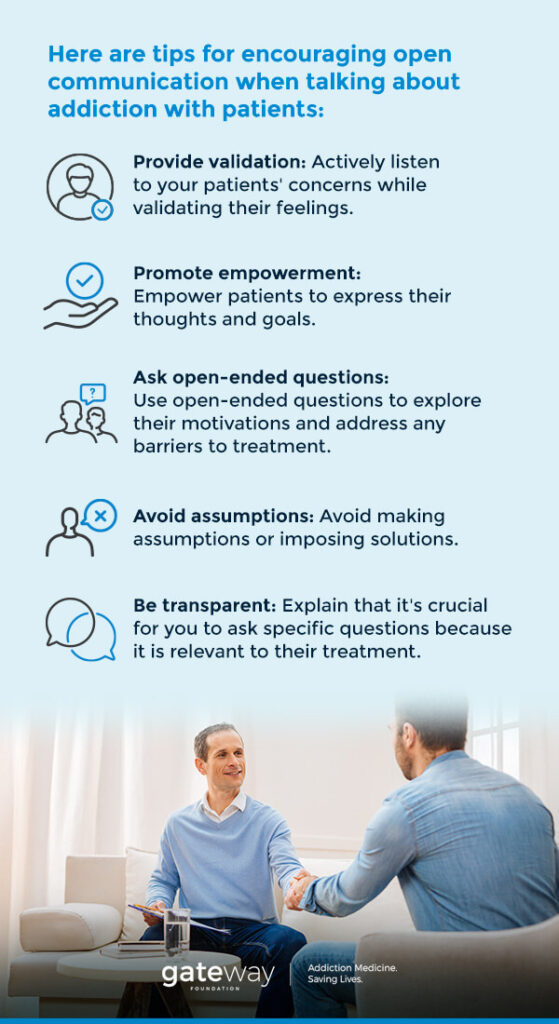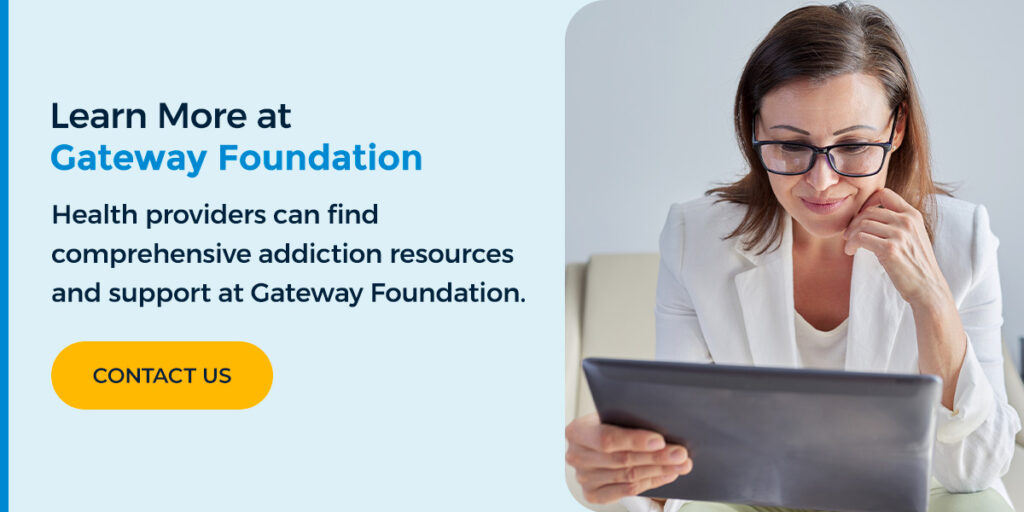- Sep 4
- Addiction

When a patient with substance use disorder (SUD) visits, it’s essential to talk to them in a way that shows sensitivity and empathy while avoiding stigmatizing language. Psychologists have found that using medically accurate language can help dismantle stereotypes outside the clinical space while providing more effective, compassionate support for people with addiction. Using motivational interviewing strategies and people-first language can help guide the conversation.
As a health provider, it’s crucial to learn how stigma affects people with addiction and how to create a supportive, compassionate clinical environment for your patients.
How Stigma Affects People With Addiction
The stigma surrounding people with substance use disorders is a common phenomenon that can significantly impact treatment outcomes, health providers, research, policies, and society.
Stigma about people with addiction might include inaccurate or unsubstantiated beliefs such as — they are dangerous, incapable of managing treatment, or at fault for their condition. These stigmas can have the following detrimental outcomes:
- Promote pity, fear, and anger toward those with addiction
- Make people with substance use disorder less willing to seek treatment
- Negatively influence how healthcare providers perceive patients with SUD, impacting the care they provide
As a clinician, you can show leadership in how language can destigmatize the disease of addiction. Remaining sensitive and nonjudgemental while encouraging open communication with your patients can trickle down into mainstream media and popular culture — influencing how society views those with addiction and leading to better treatment outcomes.
11 Tips for Talking With Patients About Substance Use Disorder

Stigma about people with SUD can stem from inaccurate beliefs that addiction is a personal failing instead of what it truthfully is — a chronic, treatable disease from which people can recover and continue to lead healthy lives. Here’s how you can alter your language to avoid these stigmas and create a safe, supportive environment for patients with addiction:
1. Use People-First Language
Patient communication in substance use disorders starts with people-first language. Let your patients choose how they are described. That way, you maintain the integrity of your patients as whole human beings rather than equating them to their condition.
Use terms that have neutral tones and distinguish the patient from their diagnosis. The National Institute on Drug Abuse recommends using the following words to reduce stigma when talking about addiction with patients:
- “Person with substance use disorder” instead of “drug addict”
- “Person with opioid addiction” instead of “user”
- “Patient” instead of “substance abuse patients” or ”drug abuser”
- “Person with alcohol use disorder” rather than “alcoholic.”
- “Use” for illicit drugs or ”drug misuse” for prescription medications instead of “abuse”
- “Being in recovery” instead of “clean”
Using first-person language can go a long way in promoting empathy in the clinical space that can then extend beyond the medical environment.
2. Use Medically-Accurate Language
When talking to your patients with SUD, their family members, and your colleagues, use language that reflects an accurate, science-based understanding of drug addiction. Because clinicians are often the first point of contact for people with SUD, it’s essential to take all necessary steps to reduce the potential for negative bias and stigma.
Accurately diagnosing an SUD is the first step. Familiarize yourself with the Diagnostic and Statistical Manual of Mental Disorders 5th Edition (DSM-5) criteria for SUDs. This ensures you have better knowledge of the specific criteria, allowing for a more practical discussion with the patient about having an SUD. It can also ensure you remain objective, use the correct language and provide proper treatment.
Using medically-accurate language empowers patients to confront their addiction with dignity and receive appropriate care. It can also foster an environment of trust and respect.
3. Ask for Permission
It’s best to start your discussion by letting your patient open up and tell their story. Here are two tips to create a comfortable environment for your patient to speak:
- Start broad: In the beginning, you’ll want to ask open-ended questions to get your patient to open up — not about their substance use issues, but their personal story. Ask them to tell you a little about themselves. If they don’t mention their history with addiction, you can ask permission to talk about it. For instance, you might say, “Would it be alright if I asked you a few questions about your substance use?”
- Be patient: Reassure your patient that they have the option not to answer if the topic makes them uncomfortable. Being patient and giving them a choice is crucial for establishing trust and respecting their autonomy. It demonstrates a patient-centered approach, where you recognize the topic’s sensitivity and acknowledge your patient’s right to privacy.
Seeking permission can help you create a safe, nonjudgmental space, encouraging open communication. Your patient will likely feel more heard and understood, which can foster a stronger therapeutic alliance and increase their likelihood of working with you toward recovery.
4. Be Aware of Body Language
The words you convey to your patient are only one part of communication — your body language is also essential to monitor. If you feel a sense of frustration or anger toward a patient and have subtle body cues like changes in eye contact, posture, or tone of voice, they might perceive these as confrontation despite your good intentions.
Pay attention to the following:
- Sit at the same level as your patient instead of standing
- Make eye contact
- Maintain an open posture
- Avoid crossed arms
- Be encouraging and empathetic during their story
Being mindful of your nonverbal cues can foster trust and build a safe space where your patients feel comfortable sharing their experiences and seeking help.

5. Establish Trust and Show Empathy
Building trust and showing empathy toward patients struggling with addiction is crucial. Here are a few tips to achieve this:
- Active listening: The first step toward an open and honest discussion is active listening. Listen attentively to your patient’s experiences, feelings, and challenges. Show genuine interest in their journey.
- Empathetic language: Validate your patient’s emotions and experiences by showing empathy toward the difficulties they face or have faced.
- Transparency: Be honest about treatment options, expectations, and potential challenges. Transparency helps build trust and avoids surprises.
- Avoiding judgment: Refrain from stigmatizing language, blaming, or shaming your patient. Instead, express understanding and encouragement.
- Be patient: Addiction recovery is a lifelong journey that requires time and effort. Be patient and express your willingness to support your patient in their journey.
- Encourage self-reflection: Encourage your patients to explore their values and motivations. That way, you foster an environment of empowerment and self-awareness.
- Demonstrate consistency: Remain consistent and reliable in your approach, showing your patient that you are there for them consistently.
- Celebrate progress: Acknowledge and celebrate even the smallest steps toward positive change and recovery.
Express to your patient that you intend to connect them to comprehensive services they might need and that recovery is possible.
6. Acknowledge Struggles and Courage
Acknowledging your patient’s struggles and courage is essential to providing compassionate and effective care. By recognizing your patient’s challenges, you validate their experiences and efforts in facing the complexities of the disease of drug addiction. Expressing your empathy and understanding shows that you genuinely care and are committed to supporting them on their recovery journey.
Support your patient by recognizing their courage in seeking help and facing their addiction. You’ll demonstrate respect for their resilience, which can encourage them to continue their efforts. It also fosters a positive therapeutic relationship built on trust and mutual respect.
As a health provider, your acknowledgment can be a powerful source of validation and motivation for your patient to overcome obstacles and embrace change. By affirming their bravery and progress, you promote self-empowerment and help them build a stronger foundation for a lasting recovery.
7. Be Objective
It’s crucial that you objectively share the risks of addiction. Here are a few tips for creating a nonjudgmental space for objective conversation:
- Be upfront and accurate: Explain right away how substances can impact overall health and deliver precise only, unbiased information.
- Provide education: Educating about the potential risks of long-term substance use can be helpful since some patients might not be aware of certain substance-induced health conditions and how they can contribute to more issues in the long run.
- Avoid subjective language: Being objective lets patients make informed decisions about their health without feeling stigmatized or misunderstood. Avoid subjective language and provide comprehensive information about the risks of addiction to help patients understand the importance of seeking appropriate treatment.
- Motivational interviewing (MI): Motivational interviewing is a great way to encourage patients to think about what change could look like. Some might be aware of the detrimental effects of chronic drug use but have not yet been able to verbalize or reflect upon those risks. This form of therapy can motivate them to work toward healthy lifestyle changes.
Objectivity allows you to respect each patient’s autonomy while offering guidance based on scientific knowledge — ultimately supporting them in making informed choices for their well-being.
8. Encourage Open Communication
As a health provider, you must be transparent and encourage open communication when talking to patients with addiction. When you create a judgment-free environment, patients will feel safe sharing their experiences and emotions without fear of stigma. Here are tips for encouraging open communication when talking about addiction with patients:

- Provide validation: Actively listen to your patients’ concerns while validating their feelings.
- Promote empowerment: Empower patients to express their thoughts and goals in their recovery journey, giving them a sense of ownership and autonomy.
- Ask open-ended questions: Use open-ended questions to explore their motivations and address any barriers to treatment.
- Avoid assumptions: Avoid making assumptions or imposing solutions. Instead, collaborate with patients to develop personalized plans that align with their needs and goals.
- Be transparent: Explain that it’s crucial for you to ask specific questions because it is relevant to their treatment. For example, you might say, “I need to ask you some specific questions about your substance use to better understand how to keep you safe and improve your health.”
Being transparent and facilitating open communication demonstrates your commitment to understanding and helping them on their path to recovery.
9. Normalize the Conversation
Normalizing the conversation can help create a supportive environment and reduce stigma. Acknowledging that addiction is a common and treatable medical condition helps patients feel less isolated and judged. Conveying your empathy and understanding lets you foster an open discussion where patients feel safe sharing their experiences.
Let your patient know that any discomfort they might feel is normal and that they are not alone. For instance, you might say, “This is not unusual. Many patients find it hard to talk about their substance use.” You might also educate your patient on addiction’s biological and psychological aspects to dispel misconceptions about addiction and reduce stigma.
Normalizing the conversation about drug addiction helps break down barriers to seeking help. It encourages your patients to view treatment as a positive step toward well-being rather than a source of shame. Embrace a non-stigmatizing approach, and you can create a therapeutic space where your patients can open up about their struggles and receive the support they need for a lasting recovery.
10. Promote Collaboration
Promoting collaboration as a health provider helping a patient with addiction is crucial for achieving positive treatment outcomes. Collaboration means working together as a team, valuing your patient’s input, and incorporating their perspectives in decision-making. By fostering a collaborative approach, your patients can feel more empowered and respected, enhancing their engagement in the treatment process.
Collaboration also helps reduce stigma by recognizing addiction for the medical condition that it is. Through collaboration, your patients become active participants in their own recovery, making them more likely to stick to treatment plans and reach better outcomes. Additionally, working together allows for a more holistic understanding of your patient’s needs, helping you provide comprehensive and personalized care.
11. Address Co-Occurring Disorders
Addressing co-occurring conditions when working with a patient with addiction is crucial for providing comprehensive, effective care. Many individuals with addiction also struggle with underlying mental health issues, and these conditions can often reinforce one another.
Identifying underlying mental health conditions is also essential for pain management and addiction assessment. Many patients with chronic pain are prone to depression, which can exacerbate pain perception. Helping patients understand the relationship between anxiety and depression and their perception of pain can be therapeutic and help them feel like their provider is invested in their well-being as a person and not just seen as a pain patient.
Acknowledging and treating co-occurring disorders simultaneously can demonstrate your commitment to holistic healing. The approach breaks down the stigma surrounding mental health, recognizing that addiction and mental health challenges are interconnected and deserve equal attention.
Learn More at Gateway Foundation
As a health provider, it’s crucial that you speak to patients with addiction with compassion, avoiding judgment or biased language. Providing an environment free of stigma can go a long way in their recovery journey and influence other health providers to do the same. Health providers can find comprehensive addiction resources and support at Gateway Foundation. We are a trusted organization with expertise in addiction treatment.
Our network of specialized facilities offers evidence-based programs for patients seeking help with substance use disorders. Referring patients to Gateway ensures they receive compassionate, personalized care from a team of experts dedicated to helping them achieve lasting recovery. Our holistic approach addresses co-occurring mental health issues, reducing stigma and creating a supportive environment.
By partnering with Gateway, you can confidently guide patients toward the resources they need for a successful recovery journey. To learn more, contact us today.



